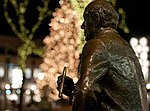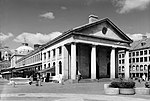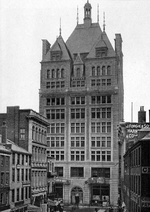Boston Custom House
1674 establishments in MassachusettsAmmi B. Young buildingsCustom houses in the United StatesCustom houses on the National Register of Historic PlacesGovernment buildings completed in 1674 ... and 6 more
Government buildings completed in 1810Government buildings completed in 1849Government buildings on the National Register of Historic Places in MassachusettsLandmarks in Financial District, BostonNational Register of Historic Places in BostonRotundas (architecture)

The Custom House in Boston, Massachusetts, was established in the 17th century and stood near the waterfront in several successive locations through the years. In 1849 the U.S. federal government constructed a neoclassical building on State Street; it remains the "Custom House" known to Bostonians today. A tower was added in 1915; the building joined the National Register of Historic Places in 1973 and was designated a Boston Landmark by the Boston Landmarks Commission in 1986.
Excerpt from the Wikipedia article Boston Custom House (License: CC BY-SA 3.0, Authors, Images).Boston Custom House
McKinley Square, Boston Downtown Boston
Geographical coordinates (GPS) Address Nearby Places Show on map
Geographical coordinates (GPS)
| Latitude | Longitude |
|---|---|
| N 42.3591 ° | E -71.0535 ° |
Address
Custom House Tower (Marriott's Custom House Hotel)
McKinley Square 3
02109 Boston, Downtown Boston
Massachusetts, United States
Open on Google Maps











